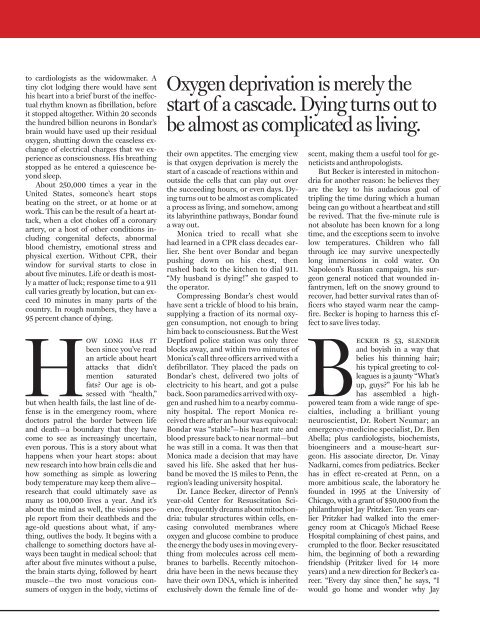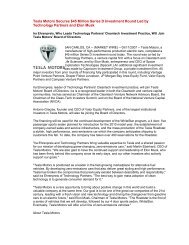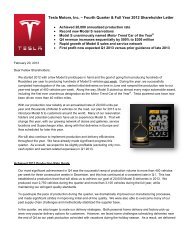This Man Was Dead; He Isn't Anymore - Technology Partners
This Man Was Dead; He Isn't Anymore - Technology Partners
This Man Was Dead; He Isn't Anymore - Technology Partners
- No tags were found...
Create successful ePaper yourself
Turn your PDF publications into a flip-book with our unique Google optimized e-Paper software.
to cardiologists as the widowmaker. Atiny clot lodging there would have senthis heart into a brief burst of the ineffectualrhythm known as fibrillation, beforeit stopped altogether. Within 20 secondsthe hundred billion neurons in Bondar’sbrain would have used up their residualoxygen, shutting down the ceaseless exchangeof electrical charges that we experienceas consciousness. His breathingstopped as he entered a quiescence beyondsleep.About 250,000 times a year in theUnited States, someone’s heart stopsbeating on the street, or at home or atwork. <strong>This</strong> can be the result of a heart attack,when a clot chokes off a coronaryartery, or a host of other conditions includingcongenital defects, abnormalblood chemistry, emotional stress andphysical exertion. Without CPR, theirwindow for survival starts to close inabout five minutes. Life or death is mostlya matter of luck; response time to a 911call varies greatly by location, but can exceed10 minutes in many parts of thecountry. In rough numbers, they have a95 percent chance of dying.How long has itbeen since you’ve readan article about heartattacks that didn’tmention saturatedfats? Our age is obsessedwith “health,”but when health fails, the last line of defenseis in the emergency room, wheredoctors patrol the border between lifeand death—a boundary that they havecome to see as increasingly uncertain,even porous. <strong>This</strong> is a story about whathappens when your heart stops: aboutnew research into how brain cells die andhow something as simple as loweringbody temperature may keep them alive—research that could ultimately save asmany as 100,000 lives a year. And it’sabout the mind as well, the visions peoplereport from their deathbeds and theage-old questions about what, if anything,outlives the body. It begins with achallenge to something doctors have alwaysbeen taught in medical school: thatafter about five minutes without a pulse,the brain starts dying, followed by heartmuscle—the two most voracious consumersof oxygen in the body, victims ofOxygen deprivation is merely thestart of a cascade. Dying turns out tobe almost as complicated as living.their own appetites. The emerging viewis that oxygen deprivation is merely thestart of a cascade of reactions within andoutside the cells that can play out overthe succeeding hours, or even days. Dyingturns out to be almost as complicateda process as living, and somehow, amongits labyrinthine pathways, Bondar founda way out.Monica tried to recall what shehad learned in a CPR class decades earlier.She bent over Bondar and beganpushing down on his chest, thenrushed back to the kitchen to dial 911.“My husband is dying!” she gasped tothe operator.Compressing Bondar’s chest wouldhave sent a trickle of blood to his brain,supplying a fraction of its normal oxygenconsumption, not enough to bringhim back to consciousness. But the WestDeptford police station was only threeblocks away, and within two minutes ofMonica’s call three officers arrived with adefibrillator. They placed the pads onBondar’s chest, delivered two jolts ofelectricity to his heart, and got a pulseback. Soon paramedics arrived with oxygenand rushed him to a nearby communityhospital. The report Monica receivedthere after an hour was equivocal:Bondar was “stable”—his heart rate andblood pressure back to near normal—buthe was still in a coma. It was then thatMonica made a decision that may havesaved his life. She asked that her husbandbe moved the 15 miles to Penn, theregion’s leading university hospital.Dr. Lance Becker, director of Penn’syear-old Center for Resuscitation Science,frequently dreams about mitochondria:tubular structures within cells, encasingconvoluted membranes whereoxygen and glucose combine to producethe energy the body uses in moving everythingfrom molecules across cell membranesto barbells. Recently mitochondriahave been in the news because theyhave their own DNA, which is inheritedexclusively down the female line of descent,making them a useful tool for geneticistsand anthropologists.But Becker is interested in mitochondriafor another reason: he believes theyare the key to his audacious goal oftripling the time during which a humanbeing can go without a heartbeat and stillbe revived. That the five-minute rule isnot absolute has been known for a longtime, and the exceptions seem to involvelow temperatures. Children who fallthrough ice may survive unexpectedlylong immersions in cold water. OnNapoleon’s Russian campaign, his surgeongeneral noticed that wounded infantrymen,left on the snowy ground torecover, had better survival rates than officerswho stayed warm near the campfire.Becker is hoping to harness this effectto save lives today.Becker is 53, slenderand boyish in a way thatbelies his thinning hair;his typical greeting to colleaguesis a jaunty “What’sup, guys?” For his lab hehas assembled a highpoweredteam from a wide range of specialties,including a brilliant youngneuroscientist, Dr. Robert Neumar; anemergency-medicine specialist, Dr. BenAbella; plus cardiologists, biochemists,bioengineers and a mouse-heart surgeon.His associate director, Dr. VinayNadkarni, comes from pediatrics. Beckerhas in effect re-created at Penn, on amore ambitious scale, the laboratory hefounded in 1995 at the University ofChicago, with a grant of $50,000 from thephilanthropist Jay Pritzker. Ten years earlierPritzker had walked into the emergencyroom at Chicago’s Michael ReeseHospital complaining of chest pains, andcrumpled to the floor. Becker resuscitatedhim, the beginning of both a rewardingfriendship (Pritzker lived for 14 moreyears) and a new direction for Becker’s career.“Every day since then,” he says, “Iwould go home and wonder why Jay









